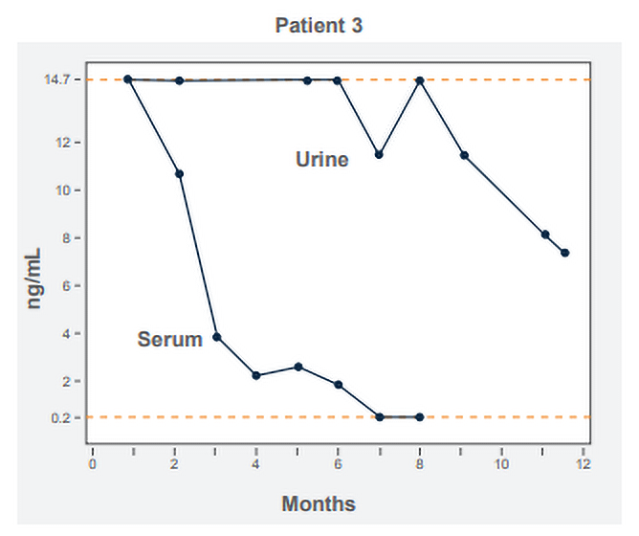What Tests Should Be Performed for Diagnosing Blastomycosis?
Andrew Hanzlicek, DVM, MS, DACVIM (SAIM); Joe Wheat, MD; Heather Largura, DDS, MS
Diagnosis
Most clinicians only order antigen on urine specimens and do not recognize the value of testing serum specimens. While the MVista Blastomyces urine antigen EIA is highly accurate, a small percentage (≤5%) of dogs with blastomycosis will test negative. In this case, the urine might be negative but the serum positive for antigen. Without testing both specimens you may miss the diagnosis. Analysis of the results obtained in 471 patients in whom both urine and serum were tested, and at least one was positive, are presented in the following table. In this example 4% of cases may have been missed if only urine was tested.
| Urine positive | Urine negative | |
|---|---|---|
| Serum positive | 75% | 4% |
| Serum negative | 21% | Not determined |
Monitoring Treatment
Antigen is quantified by extrapolation from a standard curve containing standards ranging from 0.02 ng/mL to 14.7 ng/mL. Results above the highest standard are classified as above the limit of quantification (ALQ). The reason for not providing ng/mL concentration is that the standard curve is no longer linear above the highest standard. The drawback of ALQ results is that response cannot be monitored by antigen clearance if the ALQ result is persistent. Monitoring serum antigen concentrations usually permit quantification when the urine concentration is ALQ as shown in the figure.
We Recommend
- Send both urine and serum for diagnosis of blastomycosis
- Test urine for antigen
- If the urine antigen is negative but blastomycosis is still suspect, test the serum for Blastomyces IgG antibody which may provide laboratory confirmation of the diagnosis
- If the urine antigen is ALQ, test the serum for antigen to establish a baseline for monitoring treatment
- Revert to testing urine antigen once serum antigen becomes negative
- Monitor antigen [1
Foy DS, Trepanier LA, Kirsch EJ, Wheat LJ. Serum and urine blastomyces antigen concentrations as markers of clinical remission in dogs treated for systemic blastomycosis. J Vet Intern Med 2014 Mar; 28(2):305-10. ]:- 3-month intervals during treatment
REFERENCES:
- Foy DS, Trepanier LA, Kirsch EJ, Wheat LJ. Serum and urine blastomyces antigen concentrations as markers of clinical remission in dogs treated for systemic blastomycosis. J Vet Intern Med 2014 Mar; 28(2):305-10.


